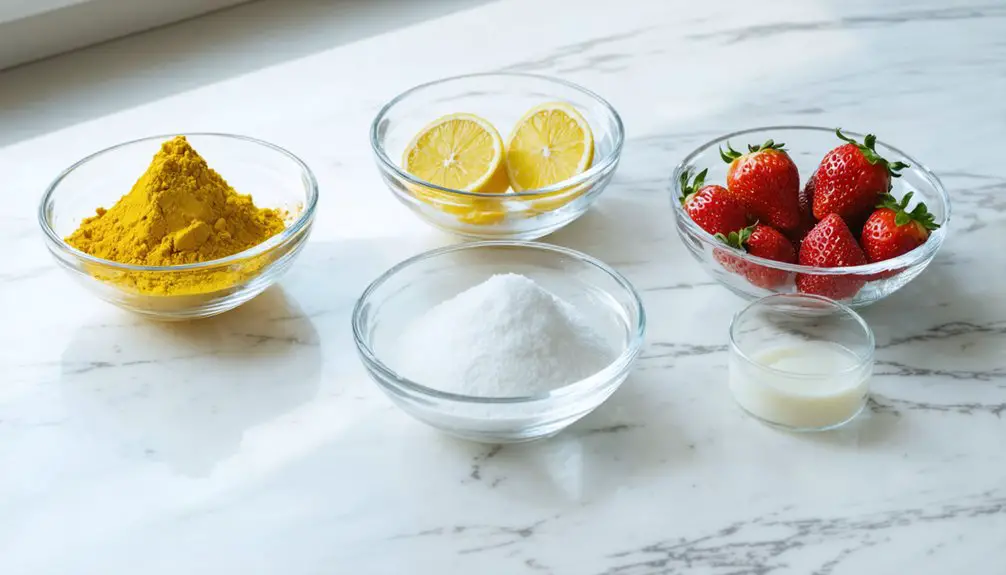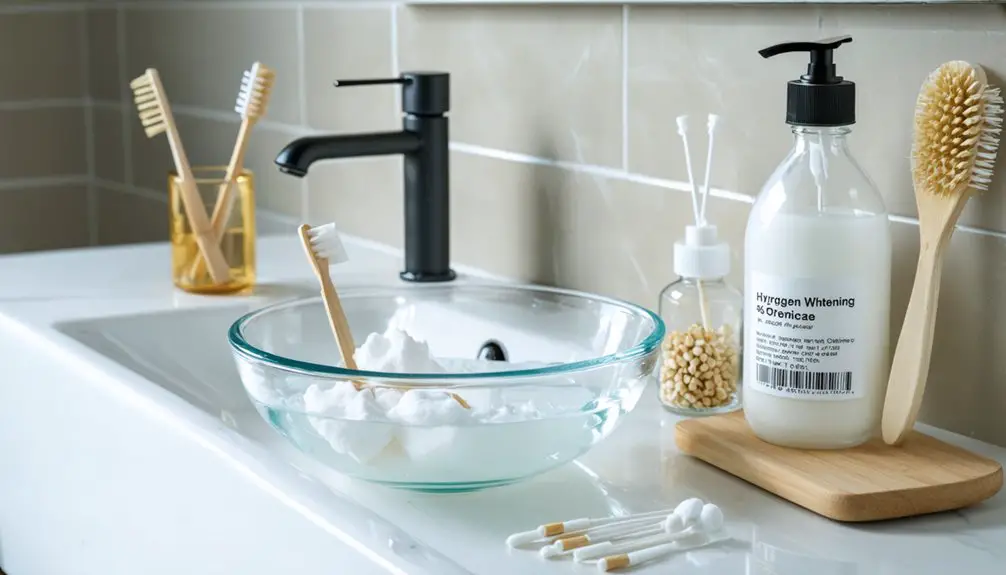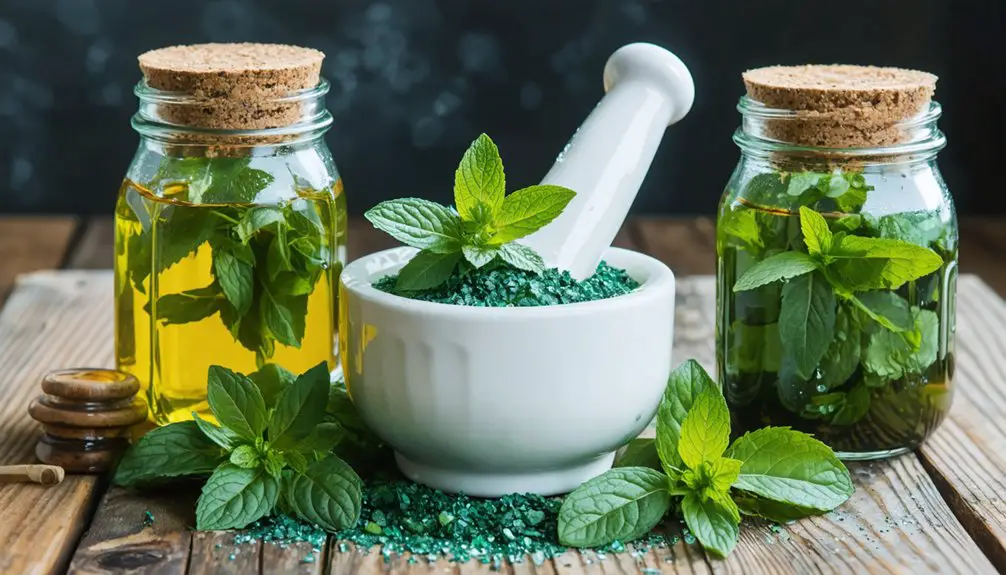You can naturally whiten your teeth using five chemical-free methods backed by research. Activated charcoal removes surface stains through gentle abrasion, while baking soda and sea salt provide a mild cleansing effect. Strawberry and banana paste contains natural acids and minerals, coconut oil pulling reduces decay-causing bacteria, and turmeric-coconut oil blend offers antimicrobial benefits. Each method requires specific application techniques and safety considerations to achieve ideal results without damaging your enamel.
Key Takeaways
- Activated charcoal can remove surface stains through abrasive action, but should be used cautiously to prevent enamel damage.
- Mix baking soda and sea salt for a gentle whitening paste, applying no more than twice weekly with a soft toothbrush.
- Create a natural paste from mashed strawberries and bananas, applying for two minutes daily to help remove surface stains.
- Practice oil pulling with coconut oil for 10-20 minutes daily to achieve gradual whitening and improved oral health.
- Combine turmeric powder with coconut oil, applying 2-3 times weekly for 5-10 minutes to help remove stains naturally.
Natural Whitening With Activated Charcoal
Recent scientific evidence raises considerable concerns about activated charcoal’s efficacy and safety as a teeth whitening treatment. Research shows that charcoal-based products deliver only minor whitening effects, primarily through abrasive removal of surface stains rather than changing your teeth’s intrinsic color. Studies comparing whitening agents found traditional peroxide-based treatments delivered significantly better results.
While marketed as a natural teeth whitener, activated charcoal shows limited effectiveness and may pose risks to dental health.
An integrative literature review examining 34 scientific articles found minimal evidence supporting charcoal’s whitening claims. While you might be drawn to this natural alternative, studies indicate that activated charcoal’s high abrasiveness can damage your enamel health. The risks include increased tooth roughness and potential long-term dental complications.
Furthermore, charcoal’s ability to inactivate fluoride may heighten your risk of dental caries. Clinical trials demonstrate that traditional whitening methods, particularly peroxide-based treatments, achieve notably better results with established safety profiles.
When considering charcoal safety, evidence suggests you’ll achieve more predictable outcomes and better enamel protection by choosing professionally recommended whitening options.
Baking Soda and Sea Salt Mixture
A popular DIY dental remedy combines baking soda and sea salt to create a natural whitening mixture. The baking soda benefits include mild abrasive properties that remove surface stains, while sea salt properties contribute additional antibacterial effects that combat plaque-causing bacteria. This affordable solution costs about 52 cents per ounce. Since it is gentle and abrasive, this mixture offers an effective alternative to commercial whitening products.
While this combination can enhance stain removal and oral cleanliness, you’ll need to use it cautiously. Apply the mixture gently with a soft toothbrush no more than twice weekly to protect your enamel.
Don’t rely on it as your sole oral care solution, as it lacks fluoride for cavity protection. If you have sensitive teeth or wear orthodontic appliances, avoid this treatment entirely.
Remember to maintain regular dental checkups and use fluoride toothpaste as part of your extensive oral care routine.
Strawberry and Banana Paste
Two popular fruit-based whitening methods involve strawberries and bananas, though scientific evidence questions their effectiveness.
Strawberry benefits stem from malic acid, which may help break down surface stains, while bananas contain minerals that support enamel health but lack proven whitening properties. Additionally, bananas contain beneficial trace minerals like potassium, magnesium, and manganese that promote enamel remineralization.
While strawberries’ malic acid tackles surface stains, bananas offer enamel-strengthening minerals but little whitening power.
To try these methods, you’ll need to mash strawberries into a pulp or gently rub the inside of banana peels on your teeth for two minutes. Regular brushing and flossing remain essential for oral hygiene while trying these natural alternatives.
While both treatments require daily application for 1-2 weeks, be cautious about overuse. The acid in strawberries can erode enamel, and banana limitations include potential yellowing effects.
Research shows these fruits work best for basic plaque removal rather than significant whitening. For safe, reliable results, consider consulting dental professionals who can recommend scientifically validated alternatives.
Oil Pulling Using Coconut Oil
Scientific evidence suggests coconut oil pulling offers a gentle alternative to chemical whitening treatments, though results emerge more gradually than peroxide-based products.
You’ll notice slight whitening effects after two weeks of consistent use, with minimal tooth sensitivity compared to peroxide whiteners.
The coconut oil benefits extend beyond aesthetics. Research shows oil pulling considerably reduces oral bacteria, particularly Streptococcus mutans, which causes tooth decay. The oil’s unique composition contains medium-chain triglycerides that support its antibacterial properties. Originating from traditional Ayurvedic medicine, this ancient practice has been used for centuries to maintain oral health.
The practice matches chlorhexidine mouthwash in controlling plaque and promoting gum health. This occurs through saponification and lauric acid’s antimicrobial properties.
For best results, swish coconut oil in your mouth for 10-20 minutes daily. While oral bacteria reduction happens within 7-14 days, whitening takes longer.
Consider this method a gentle, chemical-free addition to your dental care routine.
Turmeric and Coconut Oil Blend
While turmeric’s yellow pigment might seem counterintuitive for teeth whitening, research suggests its mild abrasive properties can help remove surface stains when combined with coconut oil. Dental professionals advise against this method due to potential staining risks.
Despite its vibrant yellow color, turmeric acts as a gentle natural abrasive that can lift tooth stains when used with coconut oil.
The turmeric benefits include natural anti-inflammatory and antimicrobial effects, while coconut oil properties feature bacteria-fighting lauric acid that targets harmful oral microbes like Streptococcus. This natural combination has proven effective for treating dental infections and maintaining optimal oral health.
To create this blend, mix one teaspoon of coconut oil with turmeric powder and apply for 5-10 minutes. You’ll need to rinse thoroughly afterward to prevent staining.
For best results, use this mixture 2-3 times weekly, following with regular brushing. While scientific evidence supporting dramatic whitening effects remains limited, this chemical-free alternative offers gentle cleaning without risking enamel damage or tooth sensitivity.
Frequently Asked Questions
How Long Should I Wait Between Different Natural Whitening Treatments?
Like stepping stones across a stream, space your natural whitening treatments several days apart. You’ll need to maintain 3-4 day intervals between different methods to prevent cumulative enamel wear.
Can Natural Whitening Methods Remove Deep Stains From Medications or Smoking?
Natural remedies won’t effectively remove deep stains from medications or smoking, as they only affect surface discoloration. You’ll need professional treatments to address these intrinsic stains that are embedded within your teeth.
Are Natural Whitening Treatments Safe During Pregnancy?
Like a protective cocoon, pregnancy demands extra caution. You shouldn’t use even natural whitening ingredients during pregnancy, as there’s insufficient safety research, and your heightened gum sensitivity increases risks of irritation.
Should I Brush Teeth Immediately Before or After Applying Natural Whiteners?
Brush thoroughly before applying natural whiteners, but wait at least 30 minutes after treatment to brush again. This timing reduces teeth sensitivity and maintains whitening frequency’s effectiveness while protecting your enamel.
How Do Natural Whitening Methods Interact With Dental Crowns and Veneers?
Natural whiteners won’t change your crown or veneer color and may damage their surfaces. While they don’t affect crown sensitivity, harsh abrasives can compromise veneer maintenance and restoration integrity over time.
References
- https://pmc.ncbi.nlm.nih.gov/articles/PMC10024105/
- https://health.clevelandclinic.org/is-teeth-whitening-safe
- https://www.trysnow.com/blogs/news/non-toxic-teeth-whitening
- https://chestnutdental.com/blog/are-natural-teeth-whitening-methods-safe-and-effective/
- https://pmc.ncbi.nlm.nih.gov/articles/PMC4058574/
- https://pubmed.ncbi.nlm.nih.gov/38316199/
- https://jdsits.in/archive/volume/13/issue/1/article/10215/pdf
- https://rsdjournal.org/index.php/rsd/article/view/22809
- https://www.todaysrdh.com/activated-charcoal-in-toothpaste-systematic-review-looks-at-whitening-and-abrasive-effects/
- https://pubmed.ncbi.nlm.nih.gov/36183933/



